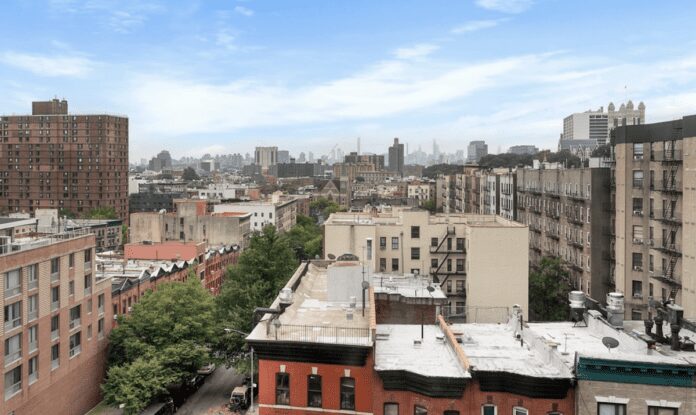(Update: as of Tuesday, May 31st the developers have withdrawn their application for zoning due to City Council member Kristin Richardson Jordan rejecting the application as not being affordable enough.)
Plans for the nearly 400-foot towers are struggling to survive as local elected officials continue to oppose its adoption, citing gentrification as the culprit.
The proposed development at the corner of West 145th Street and Lenox Avenue in Harlem isn’t looking bright. Since its first introduction to City Council last year, One45 has been facing strong opposition from both community leaders and residents.
Manhattan Borough President, Mark Levine, has voted against the project, stating that One45 doesn’t “adequately reflect neighborhood or boroughwide needs.” Specifically, Levine believes the development’s plans lack enough open space resources and transportation improvements.
While the Manhattan Borough Board’s recommendations are purely advisory, One45 developer Bruce Teitelbaum isn’t securing any tangible support from the City Council, either. D-9 Councilwoman Kristin Richardson Jordan has vehemently opposed the project since before she was even elected.
Arguably, she’s been Teitelbaum’s biggest hurdle in winning over the Council. NYC council members have a precedent of deferring their positions on proposed projects to the colleague representing the district that would be affected—in this case, Richardson Jordan.
Councilmember Kristin Richardson Jordan’s key points of opposition
Earlier this month, City Council met to discuss the future of One45. Richardson Jordan laid out strong arguments against the development, pressing Teitelbaum’s representatives on community impact issues.
The councilwoman demanded a series of adjustments to the development, including 100% of the project’s affordable units to be reserved for “very low-income” renters.
Displacement of Black Harlem residents
Having grown up in Harlem herself, Richardson Jordan has roots in the borough and is committed to preserving its Black plurality. She believes Harlem needs a housing framework that would allow formerly displaced residents a chance to move back into the neighborhood. In the last census, the borough lost 10,000 Black residents—which she affirms was not by choice, but rather a consequence of gentrification.
“We are the last Black community on the island of Manhattan and we need to take a stand. If I sound angry about this, it’s because I am, ”said Richardson Jordan at the council meeting.
During her address, the councilwoman noted that the developers of One45 had failed to complete a racial impact study and refused to hold a public meeting with community stakeholders on the project.
Of the 900+ housing units, only 282 were initially income-restricted for low and middle-income households. Richardson Jordan claimed that not only were these units not enough, but they also weren’t accurately calculated.
Although mandatory inclusionary housing practices were being used as affordability metrics in the calculation of what would be considered “affordable” units for this project, the councilwoman highlighted that this metric was not tailored to the median income of Harlem residents. Using it would disqualify about half of the households in Harlem.
Large upzoning should include community input
Some would say this project was destined to face fierce disapproval from the Council, given that community input was not factored into its original plans. The proposal would result in the construction of two towers, each standing at 363 feet tall, occupying almost an entire city block.
A development that large in size necessitates special permits and a rezoning of the area. Richardson Jordan says that it’s “unacceptable” for the developers to push a rezoning of that size without proper community input. She’s requested for the developers to pull the proposal and start over from scratch, this time with community collaboration front and center.
Congestion, noise pollution, & an inconsistent aesthetic
Although a handful of Harlem residents are in favor of the development and believe that One45 would bring more economic opportunities to the borough, an overwhelming majority of Harlemites at the council meeting spoke out against the project.
Aside from gentrification, residents are also concerned about the transportation issues that are likely to arise at the nearby bus depot and train station. There’s already a lack of parking in the neighborhood, which would be exacerbated with the introduction of two mixed-use towers spanning nearly one million square feet of office, residential, and retail space.
Harlem residents also expressed their dissatisfaction with the overall design of the project, citing that the two massive towers would be an aesthetic misfit to the community. With plans to house commercial units, community space, and a rooftop event venue, concerns of noise pollution were also raised.
Al Sharpton pulls back on plans for One45 in support of more affordable units
Until recently, the Museum of Civil Rights formed part of One45’s construction plans. On May 2nd, the Civil Rights Foundation pulled out of the project in favor of more affordable and senior housing units. Co-founder Rev. Al Sharpton sent a formal letter to the developers revealing that the organization was withdrawing its application to open the museum at One45. In his letter, Sharpton urged developers to instead use the space that was intended for the museum, to house seniors and low-income families.
“We have decided to pursue the two other very live, viable options for the Museum of Civil Rights to be at the size and commitment we want,” Sharpton wrote in his letter, which was shared with the public. Although Shaprton did not explicitly mention what the other two options are, real estate developer Don Peebles hinted towards the Affirmation Tower being a potential home for the museum.
Developers try to sweeten the deal by increasing affordable housing units
Following the public withdrawal of the Museum of Civil Rights from the project and the Reverend’s request for more housing units, Teitelbaum and his team decided to adjust development plans. In an attempt to appease project critics, One45 developers increased the percentage of subsidized apartments to 40% of the total development, totalling 367 apartments.
Of those 367 apartments, 173 apartments were set aside for “very low” and “extremely low” income households, defined as a family of two earning $53,400. The rest of the 194 subsidized units would be available for New Yorkers earning between $64,080 and $85,440.
About half of Harlem households make below the $53,400 threshold, bringing us back to Richardson Jordan’s earlier point about the Mandatory Inclusionary Housing program not being an adequate affordability metric for Harlem residences.
Lawmakers call out developers for breadcrumbing residents
Despite the developers’ attempts to sweeten the deal, Richardson Jordan did not back down and instead, slammed the last-minute changes to the proposal as “11th hour breadcrumbs.” Teitelbaum and his team had submitted the changes mentioned above just moments before the council meeting.
Last month, the councilwoman called out One45 developers for similar behavior regarding the inclusion of the civil rights museum, calling it a “Trojan horse” on twitter. At the council meeting, she urged her colleagues to block the proposal until the developers made the changes requested by the community.
It’s clear Richardson Jordan does not believe the project would do enough for her community. A self-proclaimed democratic socialist, she’s hesitant to deposit her faith in corporate partners.
“Luxury real estate developers and their accomplices are exploiting Harlem’s legacy and Black history to displace Black families while personally enriching themselves,” reads one of her tweets.
Manhattan Community Board member Karen Dixon shared Richardson Jordan’s concerns at the hearing. “Much has been said to the community that we should embrace this proposal because of the added number of affordable units. Why should we settle when the needs in the community [are] greater than what is proposed?,” she said.
One45 is unlikely to move forward without Richardson Jordan’s support
Despite being given the green light by the Planning Commission, One45 faces a difficult path to approval given that Richardson Jordan won’t budge on her opposition to the project. It’s not common practice for the Council to override the local council member’s position on a zoning project within their district.
Although it’s happened before in the Upper East Side with the approval of the New York Blood Center’s building, chair of the land use committee, Councilmember Rafael Salamanca (D-The Bronx), says the Council is unlikely to go against Richardson Jordan’s stance on the development.
In order to rezone the land intended for the construction of One45, Teitelbaum needs the Council’s approval to build as high and as dense as currently proposed. Any other plans would send developer’s back to the planning phase.
Teitelbaum had plans of turning the development into the City’s first ECO-green Quad, a geographically defined mixed-use area designed to reduce carbon emissions and promote long-term economic equity in the new green economy.
“It’s nerve wracking,” says Teitelbaum. “You know, we’ve invested a lot of time and effort in the project. We believe in it strongly. We think we’re doing something that’s really great for the city and right for the community, but now it’s in other people’s hands.”
The Council has until June 14 to review the proposal and vote on whether they allow the project to move forward as is, or if they’ll send the developers back to the drawing board.
Vivian Tejada is a freelance real estate writer from Providence, RI. She writes SEO blogs for real estate, travel and hospitality companies. She's passionate about the future of work and helping Latin American freelancers achieve time, location, and financial freedom. When she’s not writing you can find her at the gym, a family cookout, or at brunch with her girls. Follow her on Linkedin to learn more.



